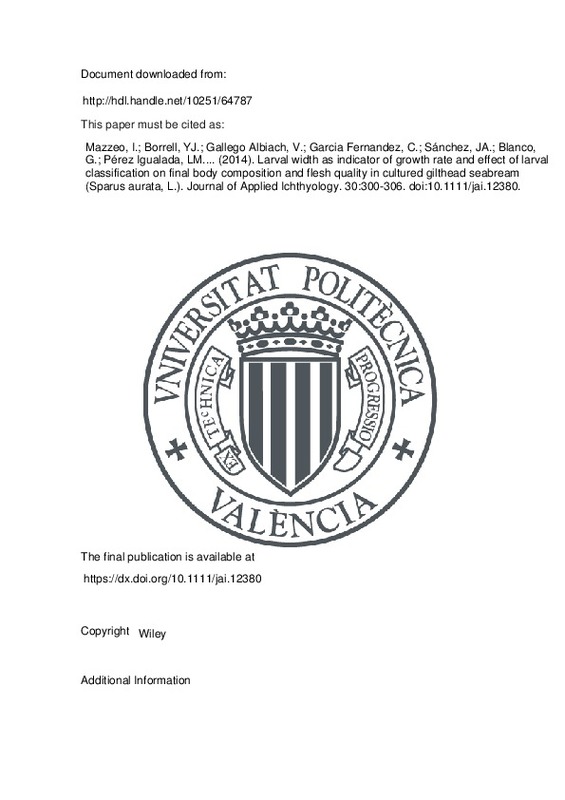Antonello, J., Massault, C., Franch, R., Haley, C., Pellizzari, C., Bovo, G., … Bargelloni, L. (2009). Estimates of heritability and genetic correlation for body length and resistance to fish pasteurellosis in the gilthead sea bream (Sparus aurata L.). Aquaculture, 298(1-2), 29-35. doi:10.1016/j.aquaculture.2009.10.022
Benedito-Palos, L., Navarro, J. C., Sitjà-Bobadilla, A., Gordon Bell, J., Kaushik, S., & Pérez-Sánchez, J. (2008). High levels of vegetable oils in plant protein-rich diets fed to gilthead sea bream (Sparus aurata L.): growth performance, muscle fatty acid profiles and histological alterations of target tissues. British Journal of Nutrition, 100(5), 992-1003. doi:10.1017/s0007114508966071
Borrell, Y. J., Carleos, C. E., Asturiano, J. F., Bernardo, D., Vázquez, E., Corral, N., … Blanco, G. (2007). Use of microsatellites and a combinatorial optimization approach in the acquisition of gilthead seabream (Sparus aurata L.) broodstocks for hatcheries. Aquaculture, 269(1-4), 200-210. doi:10.1016/j.aquaculture.2007.04.055
[+]
Antonello, J., Massault, C., Franch, R., Haley, C., Pellizzari, C., Bovo, G., … Bargelloni, L. (2009). Estimates of heritability and genetic correlation for body length and resistance to fish pasteurellosis in the gilthead sea bream (Sparus aurata L.). Aquaculture, 298(1-2), 29-35. doi:10.1016/j.aquaculture.2009.10.022
Benedito-Palos, L., Navarro, J. C., Sitjà-Bobadilla, A., Gordon Bell, J., Kaushik, S., & Pérez-Sánchez, J. (2008). High levels of vegetable oils in plant protein-rich diets fed to gilthead sea bream (Sparus aurata L.): growth performance, muscle fatty acid profiles and histological alterations of target tissues. British Journal of Nutrition, 100(5), 992-1003. doi:10.1017/s0007114508966071
Borrell, Y. J., Carleos, C. E., Asturiano, J. F., Bernardo, D., Vázquez, E., Corral, N., … Blanco, G. (2007). Use of microsatellites and a combinatorial optimization approach in the acquisition of gilthead seabream (Sparus aurata L.) broodstocks for hatcheries. Aquaculture, 269(1-4), 200-210. doi:10.1016/j.aquaculture.2007.04.055
Borrell, Y. J., Gallego, V., García-Fernández, C., Mazzeo, I., Pérez, L., Asturiano, J. F., … Blanco, G. (2011). Assessment of parental contributions to fast- and slow-growing progenies in the sea bream Sparus aurata L. using a new multiplex PCR. Aquaculture, 314(1-4), 58-65. doi:10.1016/j.aquaculture.2011.01.028
Dupont-Nivet, M., Vandeputte, M., Vergnet, A., Merdy, O., Haffray, P., Chavanne, H., & Chatain, B. (2008). Heritabilities and GxE interactions for growth in the European sea bass (Dicentrarchus labrax L.) using a marker-based pedigree. Aquaculture, 275(1-4), 81-87. doi:10.1016/j.aquaculture.2007.12.032
Gjedrem, T. (1983). Genetic variation in quantitative traits and selective breeding in fish and shellfish. Aquaculture, 33(1-4), 51-72. doi:10.1016/0044-8486(83)90386-1
Gjedrem, T. (1997). Aquaculture International, 5(3), 197-206. doi:10.1023/a:1014546816984
Grigorakis, K. (2007). Compositional and organoleptic quality of farmed and wild gilthead sea bream (Sparus aurata) and sea bass (Dicentrarchus labrax) and factors affecting it: A review. Aquaculture, 272(1-4), 55-75. doi:10.1016/j.aquaculture.2007.04.062
GRIGORAKIS, K., & ALEXIS, M. N. (2005). Effects of fasting on the meat quality and fat deposition of commercial-size farmed gilthead sea bream (Sparus aurata, L.) fed different dietary regimes. Aquaculture Nutrition, 11(5), 341-344. doi:10.1111/j.1365-2095.2005.00351.x
Grigorakis, K., Alexis, M. N., Taylor, K. D. A., & Hole, M. (2002). Comparison of wild and cultured gilthead sea bream (Sparus aurata); composition, appearance and seasonal variations. International Journal of Food Science and Technology, 37(5), 477-484. doi:10.1046/j.1365-2621.2002.00604.x
Kause, A., Quinton, C. D., Ruohonen, K., & Koskela, J. (2008). Genetic potential for the regulation of variability in body lipid and protein content of European whitefish (Coregonus lavaretus). British Journal of Nutrition, 101(10), 1444. doi:10.1017/s0007114508091265
Martínez-Llorens, S., Vidal, A. T., Moñino, A. V., Gómez Ader, J., Torres, M. P., & Cerdá, M. J. (2008). Blood and haemoglobin meal as protein sources in diets for gilthead sea bream (Sparus aurata): effects on growth, nutritive efficiency and fillet sensory differences. Aquaculture Research, 39(10), 1028-1037. doi:10.1111/j.1365-2109.2008.01961.x
Meilgaard, M., Vance Civille, G., & Thomas Carr, B. (1999). Sensory Evaluation Techniques, Third Edition. doi:10.1201/9781439832271
Navarro, A., Zamorano, M. J., Hildebrandt, S., Ginés, R., Aguilera, C., & Afonso, J. M. (2009). Estimates of heritabilities and genetic correlations for growth and carcass traits in gilthead seabream (Sparus auratus L.), under industrial conditions. Aquaculture, 289(3-4), 225-230. doi:10.1016/j.aquaculture.2008.12.024
Navarro, A., Zamorano, M. J., Hildebrandt, S., Ginés, R., Aguilera, C., & Afonso, J. M. (2009). Estimates of heritabilities and genetic correlations for body composition traits and G×E interactions, in gilthead seabream (Sparus auratus L.). Aquaculture, 295(3-4), 183-187. doi:10.1016/j.aquaculture.2009.07.012
Quinton, C. D., McMillan, I., & Glebe, B. D. (2005). Development of an Atlantic salmon (Salmo salar) genetic improvement program: Genetic parameters of harvest body weight and carcass quality traits estimated with animal models. Aquaculture, 247(1-4), 211-217. doi:10.1016/j.aquaculture.2005.02.030
Sánchez-Lozano, N. B., Martínez-Llorens, S., Tomás-Vidal, A., & Cerdá, M. J. (2009). Effect of high-level fish meal replacement by pea and rice concentrate protein on growth, nutrient utilization and fillet quality in gilthead seabream (Sparus aurata, L.). Aquaculture, 298(1-2), 83-89. doi:10.1016/j.aquaculture.2009.09.028
Shearer, K. D., Asgard, T., Andorsdottir, G., & Aas, G. H. (1994). Whole body elemental and proximate composition of Atlantic salmon (Salmo salar) during the life cycle. Journal of Fish Biology, 44(5), 785-797. doi:10.1111/j.1095-8649.1994.tb01255.x
Sitjà-Bobadilla, A., Peña-Llopis, S., Gómez-Requeni, P., Médale, F., Kaushik, S., & Pérez-Sánchez, J. (2005). Effect of fish meal replacement by plant protein sources on non-specific defence mechanisms and oxidative stress in gilthead sea bream (Sparus aurata). Aquaculture, 249(1-4), 387-400. doi:10.1016/j.aquaculture.2005.03.031
Thorland, I., Papaioannou, N., Kottaras, L., Refstie, T., Papasolomontos, S., & Rye, M. (2007). Family based selection for production traits in gilthead seabream (Sparus aurata) and European sea bass (Dicentrarchus labrax) in Greece. Aquaculture, 272, S314. doi:10.1016/j.aquaculture.2007.07.193
[-]







![[Cerrado]](/themes/UPV/images/candado.png)


